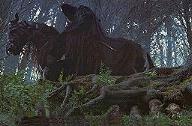
This is our first encounter with a black rider face to face in the film. What are we presented with. A black hooded faceless figure on a dark horse. The rider is at one with the horse. The two are seamlessly drawn from the same dark stuff. The same force that makes the rider worn and dark works on the horse. Both are degraded. The horse is more substantial than a normal horse and the rider more substantial than a man. Even though the figure is a towering malevolent presence there seems to be noone or rather nothing beneath the hood. The dawning sense of the insubstantiality of the hooded man seems at odds with the seeming weight of him as well as the height, emphasised by the camera angle. In the surrounding nature the two have no place. The very vitality of the natural world is forced to give way, pushed aside against their intrusion. Though the forest is abundant with life the very presence of horse and rider is a poison. The trees behind are darkened and corrupted, starved of life. This is clearly a powerful being. The horse is a symbol of will, in this case a corrupt and evil power. It is a stab into the Shire by Mordor. It seeks.
There is a clear line in the picture marked by the road level. Above the rider has come and drawn a dark curtain over the green life. Below the line the hobbits can still take cover in a relatively green world. It is clear there is no way up. Evil holds the upper ground.
We are drawn to the face of the figure. We find nothing but black. And yet the figure regards us. What is it that seeks us? By what means? This blackness beneath the hood is darker than black. It can sense us. How? With its mind or with its senses? The blackness here speaks of the shadow side of the soul, the dark side of the mind. The figure unnerves us because we have a shadow somewhere inside us and maybe this being can detect it, track us with it.
The director introduces us to the power of darkness. In Lord of the Rings darkness is not insubstantial, it is not a nothingness or void. Darkness is the shadow, a penetrating, seeking power that yearns for the source of itself, the one ring. Darkness is drawn to the ring by its will, as represented by the horse and it has the means to find it.
Absorption of light, repulsion of nature
The arrival of the Nazgul into the Shire is prefaced by a vortex. Light is pushed away from them as they approach.


< The blackness of the Nazgul is imperialistic. The blackness is a blade. The cutting black of the wraith absorbs light. Black, in the spectrum of colour is absorbing. Black takes light out of the spectrum and leaves nothing. Light is not so much extinguished as absorbed, compressed and wrung out of the spectrum. Not only is light repelled but also nature.

The presence of the Nazgul drives life out of the ground. Life is driven away. The hand of the Nazgul can only push away, repell. The hand of the Nazgul is for denial of life by repulsion. The raising of the hand of the wraith is a signal for life and light to retreat.
The wraith is a vortex in motion. The ground it moves into is pushed away, bleached out of it's life and light. We experience this as the outer edge of a vortex, as a force of repulsion. The wraith then pushes against us. The energy is purely forceful. The sensation of this force is utterly devoid of any feeling, it doesn't care what we think or feel about it. The black hand is always pushing away.

Yet at the centre of this repelling force is a deadly attraction. The centre of the vortex is the black face of the king. It would draw us in to itself. The black would absorb our life and light and draw us to itself. We would experience this a a desire to put on the ring, to complete the circuit and be absorbed.
Again and again in Fellowship we see the two qualities of black to convey evil. There is both absorption of light and repulsion of nature in the Dark Lord, the tower of Orthanc, the staff of Saruman and in the Eye itself.
© simonscott2002
|